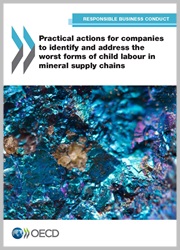Child labour risks in the minerals supply chain
International law and policy on child labour is premised upon the belief that each child has inherent dignity and worth as a human being. A global priority is to eliminate without delay the worst forms of child labour as defined by Article 3 of ILO Convention No. 182.
The OECD Due Diligence Guidance for Responsible Mineral Supply Chains identifies the worst forms of child labour as a serious human rights abuse associated with the extraction, transport or trade of minerals that companies should not tolerate, profit from, contribute to, assist with or facilitate in the course of doing business. Although the Due Diligence Guidance recommends that companies implement a supply chain due diligence risk framework in order to respect human rights, there is little detail available on how companies can conduct due diligence of child labour-related risks.
|
Date of publication |
Practical actions for companiesThe OECD has developed Practical actions for companies to identify and address the worst forms of child labour in mineral supply chains to help them identify, mitigate and account for the risks of child labour in their mineral supply chains. It has been developed to build on the due diligence framework of the OECD Due Diligence Guidance. This publication was released at the 2017 Forum on responsible mineral supply chains.
|
|
|
|
Further reading
Ending child labour, forced labour and human trafficking in global supply chains OECD Guidelines for Multinational Enterprises OECD Due Diligence Guidance for Responsible Business Conduct |
Related Documents


